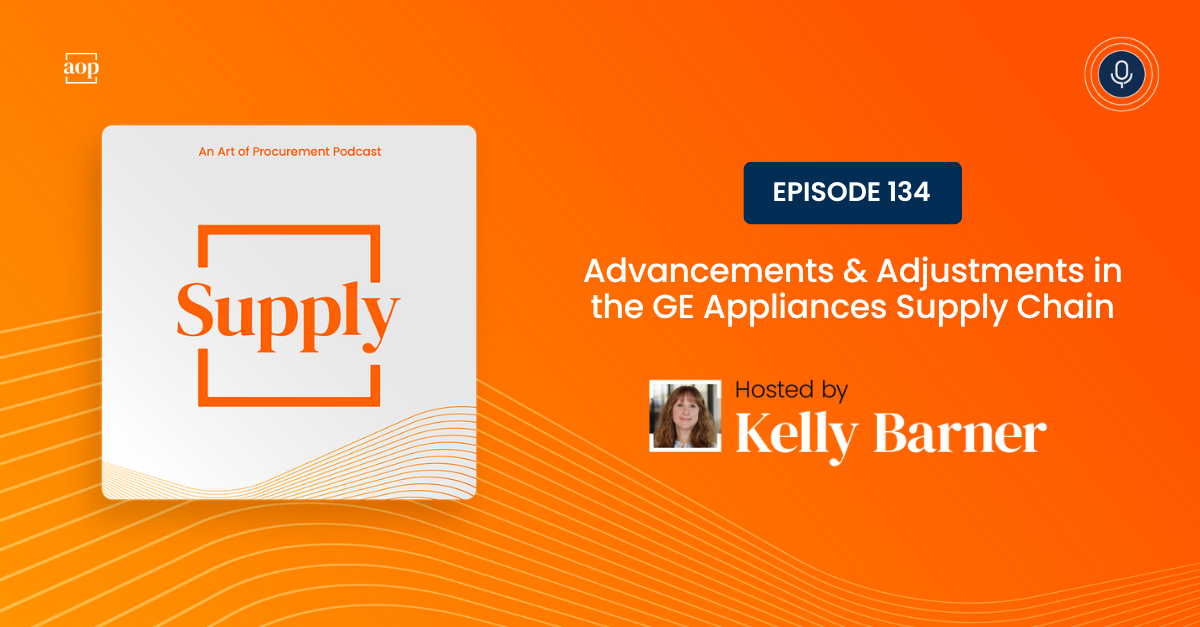3 min read
Advancements & Adjustments in the GE Appliances Supply Chain
Kelly Barner : September 12, 2024

GE Appliances is a subsidiary of Haier Smart Home, a Shanghai-based company that purchased them from GE in 2016. Until then, they were part of the GE empire, the ‘House that Jack [Welch] Built’ but which was about to come falling down. In fact, they just completed their break into three companies (aviation, healthcare, and energy) this year.
As a manufacturer of durable consumer goods, GE Appliances has to be adept at managing global production and shipping even as economic conditions change. And change they do – over and over. The challenge facing the supply chain team is not just keeping up, but getting ahead whenever possible.
In Favor of a Completely New Approach
The supply chain investments that sparked this episode of Art of Supply date back a few years.
GE Appliances’ $2 Billion supply chain investment has been underway since 2017, and accelerated in response to the pandemic. They started by working to balance out production and demand with the overall objective of growing their market share and preventing the supply chain weaknesses revealed by the pandemic from recurring.
Marcia Brey, VP of Logistics for GE Appliances, spoke to the Wall Street Journal about rejecting incremental change in favor of a completely new approach. “The way we were running distribution, the processes we were using, it wasn’t a matter of, ‘Well, just incrementally improve what you’ve got.’ “We needed to rethink, take a step back and say, ‘Are we really set up the way we need to be set up?’”
Included in GE Appliances’ new manufacturing capabilities are 7 new distribution centers, digital tools that connect their operations team with production and delivery, and reshoring – actual reshoring.
They have moved manufacturing jobs from Asia to the United States, predominantly focused around Appliance Park in Louisville, Kentucky but involving other locations as well. They have created 4,000 jobs at 9 U.S. plants, allowing GE Appliances more control over production and lowering their shipping costs.
As reported by Spectrum News in Louisville, shipping rates to the East Coast have increased by an average of $9,000 since January 2020. In addition to transportation costs, the company is saving time. Manufacturing domestically shortens the arrival time from six to eight weeks after an order to about a week, a substantial change.
Metrics for Driving Change
Rob Handfield, Bank of America University Distinguished Professor of Supply Chain Management at North Carolina State University, was quoted in the WSJ addressing GE Appliances’ emphasis on visibility as well as resilience: “A lot of companies are really striving to create increased visibility in their supply chains and also to build greater resilience in their supply chains. That includes efforts to improve coordination and integration and scheduling, and at the same time, try to reduce their inventory.”
In order to do so, GE Appliances has needed a strategy that is both internal and external and uses metrics to track the impact of each.
As Marcia Brey said, “We are shaping a supply chain where pace is purely dictated by the pull of orders from our customers. When each function in the system is operating together to reduce total system lead time (as opposed to optimising the individual functional processes), it streamlines workflow and reduces the opportunity for errors.”
Even with domestic production, GE Appliances’ supply chain still has to reach from overseas to the end consumer, wherever they might be. They can either anchor their planning on available inventory (driven by estimated demand) or actual customer demand.
They replaced ‘weeks on hand’ with ‘new customer orders delivered OTIF.’ As a result, inventory turns have improved 50% since the pandemic. GE Appliances doesn’t move a product from a distribution center until they know it is in demand in another area. Their network of warehouses is built upon the ports they use on the east and west coasts, and then relies upon hub-and-spoke to cover the rest of the country.
Despite GE Appliances’ investments in supply chain and domestic capabilities, they are still subject to challenges. A new labor contract signed in July of 2022 was quickly followed by two rounds of layoffs in salaried employees, one in November of that year and another in July of 2024. They will need to continue evaluating and evolving in order to achieve their objectives.
To hear the rest of the story, including how GE Appliances’ outsourcing and reshoring strategy has played out over time, listen to the full episode!




